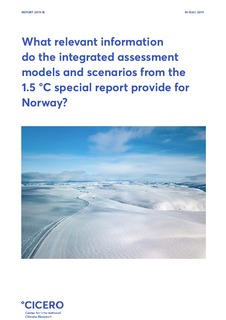| dc.description.abstract | The Norwegian Environment Agency (Miljødirektoratet) has requested a report to “get more detailed and nationally policy relevant information about the IAM-scenarios assessed in the Intergovernmental Panel on Climate Change (IPCC) Special Report on 1.5 °C global warming, and key features and assumptions in the modelling frameworks.” We present information for scenarios consistent with 1.5°C and 2°C, but avoid scenarios with large-scale bioenergy with carbon capture and storage (as requested). Among the topics discussed in this report are emission pathways, carbon price trajectories, deployment of negative emission technologies, land use change, investment needs, deployment of key abatement options, demand for primary energy and base materials, portfolio of abatement options, and scenarios. The starting point is the emission scenario database linked to the special report on global warming of 1.5 °C. However, not all information asked for by the Norwegian Environment Agency is available in the scenarios database or produced by integrated assessment models. The emission scenarios are integrated pathways (trajectories over time) developed by global integrated assessment models that represent key societal systems and their interactions, such as the energy system, agriculture, land use, and the economy. Emission scenarios consistent with 1.5 °C and 2 °C of global warming are very demanding as these targets require large-scale transformations of society and its systems, including how energy is produced, how agricultural systems are organized, and how food, energy, and materials are consumed. Some aspects of all the scenarios can be considered as unrealistic, very difficult, or in conflict with other societal objectives. Some models cannot reach ambitious climate targets, particularly 1.5°C. Accompanied with this report, we also produce large Excel documents with numerous sheets and figures on the topics discussed here | nb_NO |

